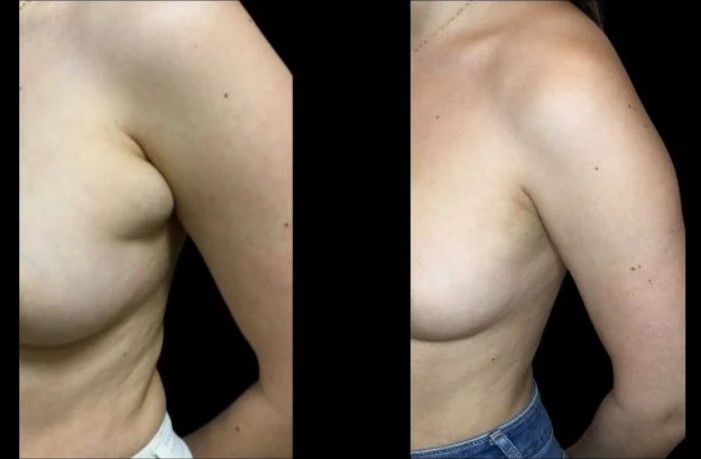Journal
How Do I Get Rid of Axillary Breast Tissues in My Armpit?
2023-09-13
Body

How Do I Get Rid of Axillary Breast Tissues in My Armpit?
Many women are concerned about the noticeable bulge in their armpit area when wearing a bra, swimsuit, or tight-fitting outfit. This stubborn pocket is either axillary breast tissues or armpit fat. In this post, we will discuss the differences between these two and what the solutions are to getting rid of axillary breast tissues.
What are Axillary Breast Tissues?
Axillary breast tissues refer to mammary tissues found between the armpits and the breasts, distinct from armpit fat. While armpit fat consists solely of adipose tissue, also known as body fat, axillary breast tissues comprise mammary glands located beyond the conventional breast areas, also known as the axilla. Medical research indicates that axillary breast tissues affect approximately 2-6% of women and 1-3% of men. These tissues may induce discomfort, pain, and aesthetic concerns due to their presence in an atypical anatomical region.
Aesthetic Concerns Due to Axillary Breast Tissues
The majority of the people seeking surgery for axillary breast tissues is due to aesthetic concerns. The accessory breast tissues can create noticeable bulges or folds in the underarm region. It can be especially difficult to conceal when wearing sleeveless or form-fitting attires, often making individuals feel self-conscious. By undergoing axillary breast tissue removal, individuals can achieve a smoother contour in the underarm area, resulting in a more natural and aesthetically pleasing appearance.
Discomfort or Pain
While rare, axillary breast tissues can cause pain or discomfort. The discomfort can arise from the weight of the tissue and the pain from the persistent rubbing or chafing against clothing or the skin. After axillary breast tissue removal surgery, it can offer relief from these symptoms, thereby enhancing overall comfort.
What Causes Axillary Breast Tissues to Grow?
Axillary breast tissues are caused by developed breast tissues outside of the breast area. While it is not dangerous to your health, the tissues can look not aesthetically pleasing and unsightly. The breast tissues can also cause pain and discomfort due to the weight of the tissues or the rubbing or chafing against clothes or skin. The main cause of axillary breast tissues is changes in hormone levels. When estrogen and progesterone levels rise and fall, the breast tissues change as well. Variations in estrogen and progesterone levels, experienced during menstrual cycles, pregnancy, puberty, and menopause, can influence the size and composition of breast tissues. Consequently, women often observe fluctuations in the size and prominence of axillary breast tissues during these hormonal transitions.
How to Differentiate Axillary Breast Tissues from Armpit Fat?
Distinguishing between axillary breast tissues and armpit fat requires attention to their distinct characteristics. While they may appear similar at first glance, their texture and responsiveness to hormonal changes provide key differentiators.
Axillary breast tissues typically possess a fibrous texture and exhibit sensitivity to shifts in hormonal levels. During periods of hormonal fluctuations such as puberty or pregnancy, these tissues may feel denser or heavier. Conversely, armpit fat remains relatively unaffected by hormonal changes and instead reflects one's overall health and weight.
Additionally, axillary breast tissues may be palpable as discrete nodules or lumps beneath the skin, while armpit fat tends to distribute more evenly throughout the underarm area. By assessing these differences in texture and hormonal reactivity, individuals can better discern between axillary breast tissues and armpit fat.

What are the Solutions to Getting Rid of Axillary Breast Tissues?
Addressing axillary breast tissues necessitates a multifaceted approach, with both non-surgical and surgical options available to individuals seeking resolution.
Exercise represents a non-invasive strategy for reducing the size of axillary breast tissues, as overall weight loss often correlates with diminished breast volume. While exercise can contribute to a decrease in breast tissue size, it's important to recognize that spot reduction of fat is not feasible. Consequently, individuals may encounter challenges in achieving uniform results, potentially resulting in a slim upper body compared with persistent bulges in the armpits.
For individuals seeking comprehensive removal of axillary breast tissues, surgical intervention, such as liposuction, emerges as the optimal solution. Liposuction entails the extraction of excess fat and breast tissues through small incisions in the armpit area, utilizing a specialized cannula for suctioning. Typically performed under local anesthesia, liposuction offers swift recovery times and yields natural-looking results. Post-operative care, including adherence to surgeon-provided instructions and wearing a compression garment, is imperative to facilitate proper healing. Common post-operative effects such as swelling, bruising, and discomfort are to be expected and can be managed with appropriate measures.
While exercise may offer some reduction in axillary breast tissue size, surgical intervention, notably liposuction, stands as the most effective method for complete removal. By weighing the benefits and considerations of each approach, individuals can make informed decisions tailored to their specific needs and preferences.
Accordingly, if you are unhappy with your armpit bulge, consult with a certified surgeon and seek professional advice. However, it is important to note that it is difficult to differentiate axillary breast tissues from armpit fat from images, so consult with a doctor in person to get an accurate assessment and solution.

Contact Us for a Free Consultation About Axillary Breast Tissue Removal in Korea
If you are considering any axillary breast tissue removal surgery or any other cosmetic procedures and would like to get more information, reach out to us by contacting us on the following:
Inquiry page: https://docfinderkorea.com/quick-inquiry/
Email: inquiry@docfinderkorea.org
WhatsApp:
+(82) 10-5811-8806 (EN/РУC)
+(82) 10-5825-8806 (EN/IND)
+(82) 10-9574-8806 (EN/繁/簡/粵)
Back


